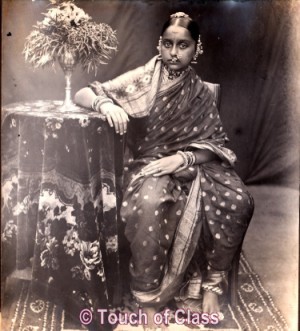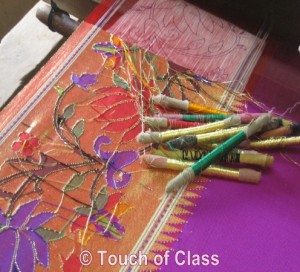| MOTIFS | HISTORY | ART |
|---|---|---|
 |
 |
 |
L E G A C Y
Paithani, popular for it’s unique art and tradition is the carrier of a legacy for over 2000 years. Born in Paithan, the splendid capital of Satvahana Dynasty in 200 BC on the banks of divine Godavari River, Paithani grew under the patronage of the Satvahana dynasty of kings. Later it progressed throughout the Deccan region. Paithani uses the ancient technique of tapestry where multiple threads of different colours along with gold and silver threads are weaved together to form a fascinating piece of silk. In the distant past, Romans imported this Golden Woven Fabric in exchange for gold of equal weight. The art of Paithani survived under changing rulers. In fact it flourished under Aurangzeb, who not only brought it back to its glory but also incorporated many novelties in appearance. The well known floral motifs and AmarVell are contributions from Mughal era.
The Nizam of Hyderabad was also an ardent admirer of Paithanis. After decline of Mughal influence, the Peshwas' of Pune once again took Paithani under their wings by settling weavers in Yeola, a small town near Shirdi. Here Paithani acquired new dimensions in both design and popularity. Asawali, a motif of flowering vine is credited to the Peshwa period. Later, in absence of royal patronage, Paithani remained an ignored textile form of Maharashtra until the Government of India together with the Government of Maharashtra and private enterprises took special interest in its revival. Once again, Paithani is becoming an iconic art of the India erasing borders of geography and religion.
WEAVING ELEMENTS OF LIFE
Paithani, that carries the cultural legacy of Maharashtra, has a special place in the life of women who are the pillars of every family and society. The ancient textile unites entire elements of life in the form of blessings and protection to the wearer. It is made from natural silk or cotton with precious gold and silver metal threads that gives Paithani the Midas touch. Particularly, the motifs that set Paithani above all other traditional fabric points to the special significance of living in harmony with nature and its elements. Traditional motifs that are still popular since its birth over 2000 years ago are derived from nature that forms essential part of human life.
The Bangle-Peacock motif (Bangadi-Mor) in which the bangle, as sign of Saubhagya, represents completeness of the being of woman. Peacock, the bird of paradise indicates beauty, royalty, wisdom, wholeness, dignity, love and is believed to be a guardian. The Peacock also carries a sense of energy that comes from its renewal of feathers every year. Its association with Goddess Sarswati represents benevolence, patience, kindness, compassion, and luck.
The Muniya or Tota-Maina motif symbolizes the parrot. Parrot is sign of love and passion. Its red beak represents the red earth before the rain or the unfulfilled desire and the green feathers representing the green earth after rains or fulfilled desire, full of joy that forms indispensable part of human life.
The Lotus or Kamal Pushpa is a motif that bears a close resemblance to the murals of Ajanta Caves located in Aurangabad, Maharashtra. It is the sign of rebirth. The Lotus closes in the evening and falls into water. But in the morning, it opens up lifting itself above the surface of water. It also represents essence of life in addition to representing royalty, beauty and purity.
The Traditional Coconut border (Narali) was the most common Paithani border until the end of 19th century. Coconut known as Sriphal in India is the fruit of gods. It symbolises complete usefulness, selfless service, prosperity and generosity. Coconut tree or Kalpvirshka is termed in Hindu mythology as the tree that grants all wishes.
The added sense of greater beauty and aesthetics in motifs such as Asawali, Akruti or Geometrical figures, Amarvell and flowering wine were introduced with the passage of time. Emperor Jahangir’s great love for nature and flowers brought many symbolic designs to this textile adding another dimension to Paithani in appearance and increasing its repertoire. Until the nineteenth century, most borders of Paithani Sarees were rather simple coconut or Pankha (hand fan) heavily woven with metal threads. Brocade borders that incorporated various motifs with silk and jari quickly became popular that gave unique identity to the Paithani saree.
Depending on design, details and size, it takes an artisan one month to two years to weave a Paithani Saree. Each Paithani Saree is a dedicated and painstaking work of an artisan who incorporates his soul and heart in weaving every thread that binds all elements of life in to the ‘one’ without which it is just another fabric. As a legacy of love and care passed down from mother to daughter for generations, Paithani holds its place as the most precious piece of heirloom that every woman possesses.
MAKING OF A PAITHANI
A Paithani saree is the result of a painstakingly complex process of weaving beginning from choosing raw silk and precious metals zari to the final product. A century ago, fine silk imported from China and locally made Zari in which gold and silver metal was woven around silk or cotton thread used in Paithani. Today, mulberry silk from Bangalore and Zari from Surat, Gujrat are used. Natural dyes, known for having been drawn for centuries, from vegetables, minerals, plants and rocks are used in a combination that gives attractive colors to silk. The Raw Silk bundles are washed followed by dying and transfer to the reels (asari) to separate each thread before loading to the loom. Setting up the loom is a meticulous job of careful handling where each thread is mounted to bring out the design, color and details to convert these into a fabulous fabric. Ancient technique of tapestry weaving where, warp and weft threads are weaved together using handloom is still practiced which offers control over every thread and thus making each Paithani saree special and different. The weavers use the method of interlocking when more than one base color is used.
Once the loom is set, there begins the journey of weaving each thread that binds elements of life into one golden fabric. Using soft handmade cotton pins wound with silk of desired colors and zari, an artisan with delicate fingers dedicates himself to the path of eternal weaving that takes anywhere between a month to five years.
Embellished with motifs and zari, Paithani takes on a personality of her own and awaits an admirer to become a family heirloom. The whole process is painstaking and takes a toll on vision and bones of the artisan making his life very difficult at times when most of us enjoy and cherish retirement and freedom.

PHILOSOPHY
This miniature painting by Rashmi Tapadia forms core philosophy of Touch of Class. It portrays a Royal woman performing religious rituals while holding her child close to heart. It depicts a royal touch in her attire, love of mother and devotion to religion, culture and tradition being the pillar of a family. Touch of Class brings you a great legacy of Culture, Tradition and Love that cannot expressed in a more beautiful and profound manner.
Paithani is a family heirloom worth caring for!
